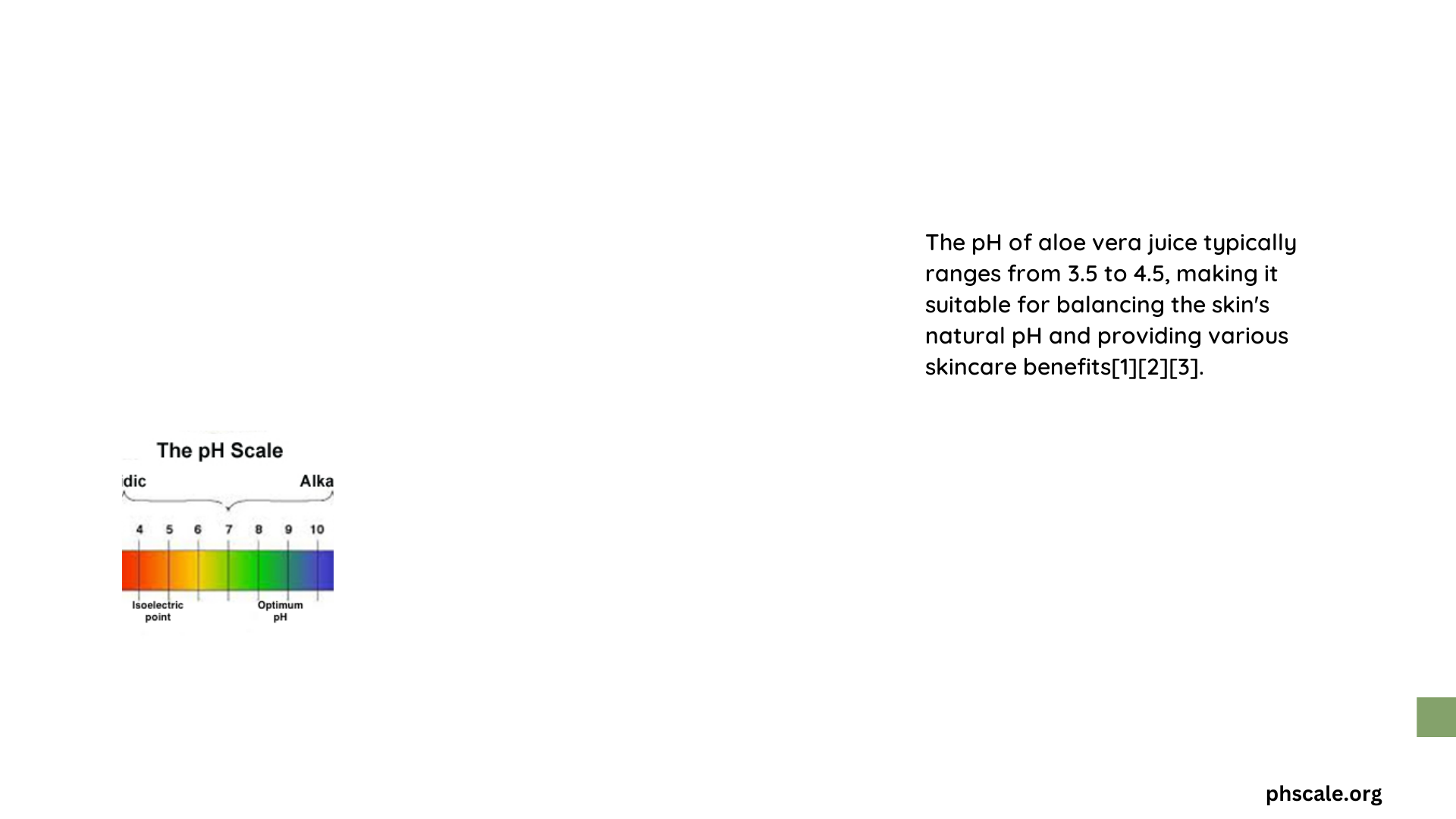Aloe vera juice, known for its numerous health benefits, has a specific pH range that contributes to its effectiveness. The pH of aloe vera juice typically falls between 3.5 and 5.0, making it slightly acidic. This acidity level plays a crucial role in maintaining the stability of its bioactive compounds and ensuring its therapeutic properties. Understanding the pH of aloe vera juice is essential for maximizing its potential benefits and proper storage.
What is the Exact pH Range of Aloe Vera Juice?
The pH of aloe vera juice can vary slightly depending on factors such as extraction methods and processing conditions. However, the typical range is:
- Fresh aloe vera juice: pH 3.5 – 4.5
- Processed aloe vera juice: pH 3.5 – 5.0
- Cosmetic-grade aloe vera juice: pH 3.5 – 4.5
It’s important to note that fresh aloe vera juice tends to be on the lower end of this pH range, while processed juices may have a slightly higher pH due to added preservatives or stabilizers.
Why is the pH of Aloe Vera Juice Important?

The pH of aloe vera juice is crucial for several reasons:
-
Stability of bioactive compounds: The slightly acidic pH helps preserve the integrity of aloe vera’s beneficial components, such as polysaccharides, vitamins, and minerals.
-
Skin compatibility: For topical applications, the pH of aloe vera juice is close to the skin’s natural pH, making it less likely to cause irritation.
-
Antimicrobial properties: The acidic nature of aloe vera juice contributes to its ability to inhibit the growth of harmful bacteria.
-
Absorption: The pH level affects how well the body can absorb and utilize the nutrients in aloe vera juice.
How Does the pH of Aloe Vera Juice Affect Its Health Benefits?
The pH of aloe vera juice plays a significant role in its health benefits:
-
Digestive health: The slightly acidic nature of aloe vera juice can help balance stomach acidity, potentially alleviating symptoms of acid reflux and indigestion.
-
Skin care: The pH compatibility with skin allows for better absorption of aloe vera’s moisturizing and soothing properties.
-
Nutrient preservation: The optimal pH range ensures that vitamins, minerals, and enzymes in aloe vera juice remain stable and bioavailable.
-
Anti-inflammatory effects: The acidic pH contributes to aloe vera’s anti-inflammatory properties, which can be beneficial for various health conditions.
What Factors Can Alter the pH of Aloe Vera Juice?
Several factors can influence the pH of aloe vera juice:
-
Processing methods: Different extraction and processing techniques can affect the final pH of the juice.
-
Storage conditions: Temperature and exposure to light can cause pH changes over time.
-
Additives: Preservatives or other ingredients added to commercial aloe vera juices may alter the pH.
-
Age of the plant: The maturity of the aloe vera plant at harvest can influence the pH of its juice.
-
Growing conditions: Soil quality, climate, and watering practices can affect the pH of the aloe vera plant and its juice.
How Can You Maintain the Optimal pH of Aloe Vera Juice?
To maintain the optimal pH of aloe vera juice:
-
Proper storage: Keep aloe vera juice refrigerated between 4-8°C (39-46°F) to prevent oxidation and pH changes.
-
Use preservatives: If making homemade aloe vera juice, consider adding natural preservatives like citric acid to maintain pH stability.
-
Check expiration dates: Use commercial aloe vera juice before its expiration date to ensure optimal pH and effectiveness.
-
Avoid contamination: Use clean utensils and containers when handling aloe vera juice to prevent bacterial growth that could alter pH.
-
Monitor pH levels: If possible, use pH strips to regularly check the acidity of your aloe vera juice, especially if storing it for extended periods.
What Are the Best Ways to Consume Aloe Vera Juice for Maximum Benefits?
To maximize the benefits of aloe vera juice while considering its pH:
-
Dilution: Mix aloe vera juice with water or other juices to make it more palatable and easier on the digestive system.
-
Timing: Consume aloe vera juice on an empty stomach for better absorption of its nutrients.
-
Consistency: Drink aloe vera juice regularly (e.g., daily) for sustained benefits.
-
Quality: Choose high-quality, pure aloe vera juice without added sugars or artificial ingredients.
-
Pairing: Combine aloe vera juice with other pH-balancing foods for enhanced effects on overall body pH.
How Does the pH of Aloe Vera Juice Compare to Other Common Beverages?
To put the pH of aloe vera juice into perspective, here’s a comparison with other common beverages:
| Beverage | Typical pH Range |
|---|---|
| Aloe Vera Juice | 3.5 – 5.0 |
| Water | 6.5 – 8.5 |
| Orange Juice | 3.3 – 4.2 |
| Coffee | 4.8 – 5.1 |
| Green Tea | 7.0 – 10.0 |
| Milk | 6.4 – 6.8 |
| Cola | 2.3 – 2.5 |
As you can see, aloe vera juice is slightly more acidic than water but less acidic than many fruit juices and carbonated beverages.
Understanding the pH of aloe vera juice is crucial for harnessing its full potential. By maintaining the optimal pH range, you can ensure that you’re getting the maximum benefits from this versatile and healthful plant extract. Whether you’re using it for digestive health, skin care, or general wellness, being aware of the pH of aloe vera juice can help you make the most of its natural properties.
References:
1. Making Cosmetics – Aloe Vera Pure Juice
2. Lily of the Desert – How Aloe Vera Helps Balance pH Levels
3. Lotioncrafter – Aloe Vera Juice 1X
4. Journal of Food Science and Technology – Aloe vera juice incorporation in mixed fruit juice
5. International Journal of Research in Ayurveda and Pharmacy – Aloe vera: A review of its clinical effectiveness
